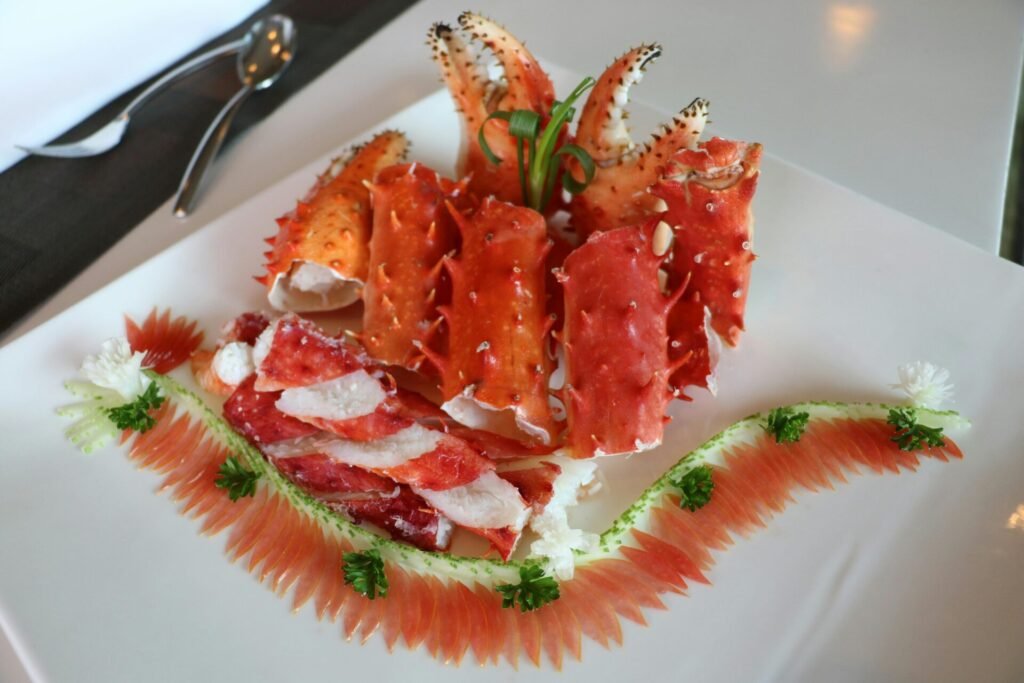Introduction: The Nutritional Powerhouse from the Ocean
Is crab meat healthy? This question frequently surfaces among seafood enthusiasts and health-conscious individuals alike. The short answer is a resounding yes—crab meat stands as one of the most nutritionally dense seafood options available, offering an impressive array of health benefits when prepared properly. This oceanic delicacy delivers exceptional protein content while remaining remarkably low in calories, making it an excellent choice for various dietary needs.
The Nutritional Profile of Crab Meat: A Closer Look
Before diving into specific health benefits, understanding the nutritional composition of crab meat provides valuable context for why this seafood deserves a place in a balanced diet.
Protein Powerhouse
Crab meat shines as an exceptional source of high-quality protein. A standard 3-ounce serving provides approximately 16-20 grams of protein, depending on the variety. What’s particularly impressive is that this protein comes with minimal caloric investment—most crab varieties offer this substantial protein content at just 70-75 calories per serving.
The protein in crab meat contains all essential amino acids, making it a complete protein source that supports muscle maintenance, immune function, and overall cellular health. For individuals focused on increasing protein intake while managing calories, crab meat represents an efficient nutritional choice.
Vitamin and Mineral Content
Beyond protein, crab meat delivers an impressive spectrum of essential vitamins and minerals:
- Vitamin B12: Crucial for nerve function and DNA synthesis
- Zinc: Supports immune function and wound healing
- Copper: Essential for red blood cell formation and immune health
- Selenium: A powerful antioxidant that protects cells from damage
- Phosphorus: Important for bone health and cellular energy production
- Omega-3 fatty acids: Present in modest amounts, supporting heart and brain health
This nutrient density makes crab meat particularly valuable for addressing specific nutritional gaps that commonly occur in many diets.
Calorie Content: A Dieter’s Friend
For those monitoring caloric intake, crab meat offers substantial nutritional benefits without the calorie density of many other protein sources. The calorie content varies slightly by crab type:
- Blue crab: Approximately 74 calories per 3-ounce serving
- Alaska king crab: Around 71 calories per 3-ounce serving
- Dungeness crab: Nearly 73 calories per 3-ounce serving
What makes these numbers particularly impressive is that roughly 85 percent of these calories come directly from protein, with minimal contributions from fat and carbohydrates. This macronutrient profile aligns perfectly with many contemporary dietary approaches focused on protein prioritization.
Comparing Crab Varieties: Nutritional Differences
Not all crab varieties offer identical nutritional profiles. Understanding these differences helps consumers make informed choices based on specific health considerations.
Blue Crab
Blue crab meat delivers excellent protein content with a distinctive sweet flavor. Nutritionally, it contains:
- 74 calories per 3-ounce serving
- Approximately 66 milligrams of cholesterol
- Roughly 250 milligrams of sodium
- Less than 0.2 grams of saturated fat
Its moderate sodium content makes it suitable for individuals who need to monitor sodium intake but still want to enjoy seafood.
Alaska King Crab
Known for its impressive size and sweet, tender meat, Alaska king crab offers:
- 71 calories per 3-ounce serving
- Just 36 milligrams of cholesterol (lowest among common crab varieties)
- Higher sodium content at approximately 711 milligrams per serving
- Minimal saturated fat at less than 0.2 grams
The significant difference in sodium content makes king crab a consideration for those with hypertension or sodium restrictions, while its lower cholesterol content may appeal to those monitoring cholesterol intake.
Dungeness Crab
This Pacific coast favorite presents a balanced nutritional profile:
- 73 calories per 3-ounce serving
- About 56 milligrams of cholesterol
- Approximately 250 milligrams of sodium (similar to blue crab)
- Less than 0.2 grams of saturated fat
Dungeness crab represents a middle-ground option that balances flavor with moderate sodium and cholesterol levels.
Health Considerations: Cholesterol, Sodium, and Heart Health
While crab meat offers numerous health benefits, certain aspects warrant consideration, particularly for individuals with specific health concerns.
Cholesterol in Crab Meat: Context Matters
Some consumers express concern about the cholesterol content in crab meat. Current dietary guidelines recommend limiting cholesterol intake to 300 milligrams daily for healthy individuals, or 200 milligrams for those with elevated blood cholesterol.
A three-ounce serving of crab meat contains varying amounts of cholesterol depending on the type:
- Blue crab: 66 milligrams
- Dungeness crab: 56 milligrams
- Alaska king crab: 36 milligrams
However, nutritional science has evolved to recognize that dietary cholesterol alone doesn’t necessarily translate to elevated blood cholesterol levels for most individuals. The relationship between dietary cholesterol and blood cholesterol involves multiple factors, including genetic predisposition and overall dietary patterns.
More significant than cholesterol alone is saturated fat consumption, which has a stronger correlation with elevated LDL (low-density lipoprotein) cholesterol. Importantly, crab meat contains minimal saturated fat—less than 0.2 grams per 3-ounce serving across most varieties. This makes crab meat a heart-friendly protein option despite its moderate cholesterol content.
Sodium Considerations
Sodium content represents another important consideration, particularly for individuals managing hypertension or heart health conditions. The sodium content varies significantly between crab varieties:
- Alaska king crab contains approximately 711 milligrams per 3-ounce serving
- Blue crab and Dungeness crab each contain under 251 milligrams per serving
Current recommendations suggest limiting sodium intake to 2,300 milligrams daily for healthy individuals and 1,500 milligrams for those with hypertension. Adding salt during preparation or consumption significantly increases sodium intake—just 1/8 teaspoon of salt adds approximately 300 milligrams of sodium.
For those monitoring sodium intake, blue crab and Dungeness crab represent better options. Alternative seasoning approaches using herbs, citrus, and pepper can enhance flavor without increasing sodium content.
Maximizing Health Benefits: Preparation Methods Matter
The health benefits of crab meat can be easily undermined through preparation methods. The nutritional profile discussed above reflects plain steamed crab meat without additional ingredients.
Impact of Common Accompaniments
Traditional crab accompaniments can dramatically alter the nutritional profile:
- One tablespoon of melted butter adds approximately 100 calories, predominantly from fat (including saturated fat)
- Creamy dipping sauces contribute additional calories, fat, and often sodium
- Breaded and fried crab preparations significantly increase calorie and fat content
Healthier Preparation Methods
To maintain the nutritional integrity of crab meat:
- Steam or boil crab without adding salt to the cooking water
- Enhance flavor with fresh herbs, lemon juice, garlic, or pepper instead of salt or butter
- Consider serving with heart-healthy olive oil with herbs instead of butter
- Pair with vegetables and whole grains for a balanced meal
Incorporating Crab Meat into a Balanced Diet
For those looking to benefit from crab meat’s nutritional advantages, consider these practical approaches:
Healthy Crab Recipe Ideas
- Mediterranean Crab Salad: Combine lump crab meat with diced cucumber, cherry tomatoes, red onion, and a light dressing of olive oil, lemon juice, and herbs.
- Crab-Stuffed Bell Peppers: Mix crab meat with brown rice, diced vegetables, and herbs, then bake in halved bell peppers.
- Crab and Avocado Stack: Layer crab meat with sliced avocado, drizzle with a small amount of olive oil, and season with fresh herbs and lemon zest.
- Crab and Vegetable Soup: Add crab meat to a broth-based soup with plenty of vegetables for a nutritious, satisfying meal.
Frequency Recommendations
For most healthy individuals, incorporating crab meat into the diet 1-2 times per week aligns with general seafood consumption recommendations while providing valuable nutritional benefits. Those with specific health conditions should consult healthcare providers for personalized guidance.
Sustainability Considerations
While focusing on health benefits, responsible consumption includes attention to sustainability. When purchasing crab:
- Look for Marine Stewardship Council (MSC) certification
- Consider choosing Dungeness crab, which generally has well-managed fisheries
- Be aware of seasonal availability that aligns with sustainable harvesting practices
Conclusion: A Valuable Addition to a Healthy Diet
Is crab meat healthy? The evidence clearly supports crab meat as a nutritionally valuable protein source. With its impressive protein content, minimal calorie investment, abundance of essential vitamins and minerals, and negligible saturated fat content, crab meat deserves consideration in a balanced diet.
By understanding the nutritional differences between crab varieties and employing health-conscious preparation methods, consumers can fully benefit from this delicious seafood option. Whether enjoyed occasionally as a culinary treat or incorporated regularly into meal planning, crab meat offers a delicious way to support overall nutritional needs.
As with any dietary component, individual health conditions and nutritional requirements should guide consumption patterns. For those with specific health concerns, consulting with healthcare providers ensures that dietary choices, including crab meat consumption, align with personal health goals.


